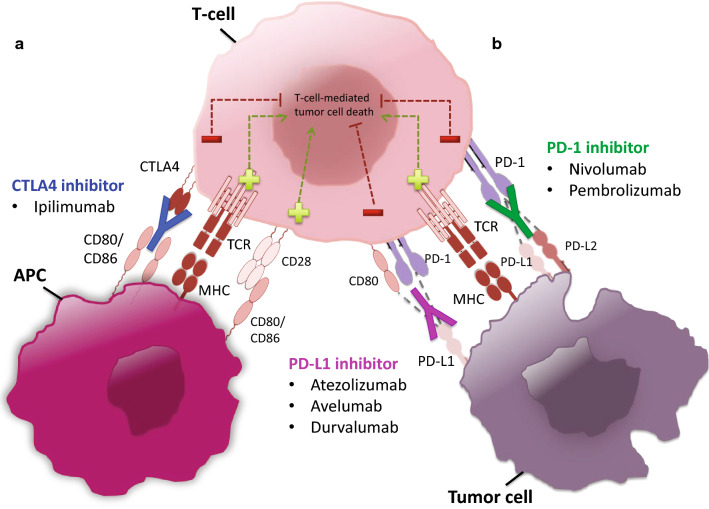Fig. 1.
Molecular targets of ICIs. Tumor cells have the capacity to override the host immune system and hamper antitumor reaction. One means by which this occurs is by dampening T-cell response. Inhibition of T-cells can transpire at various stages of their antitumor response and arises upon activation of suppressor surface receptors by their respective ligands [114]. ICIs have been tailored to antagonize this reaction by binding to inhibitory proteins involved in the supression of antitumor reactions, thereby liberating the host immune reaction against tumor cells. Priming phase: In the priming phase, naïve T cells in the lymphoid organs become exposed to tumor-specific antigens, resulting in the differentiation of naïve T cells into effector T cells (e.g. Treg, cytotoxic T cells and helper T cells). This represents the initial step of an adaptive reaction against tumor cells, which is supported by the co-stimulatory effect of the CD28 receptor with CD80/86. The effect of CD28 becomes restrained in the presence of the CTLA-4 receptor, which holds a much higher affinity for the CD80/86 ligands. CTLA-4-blocking antibodies hamper this constraint and restore the formation of effector T cells to generate an antitumor response. Moreover, anti-CTLA-4 antibodies might be involved in the depletion of CTLA-4 expressing Treg cells in the tumor microenvironment. Effector phase: In the effector phase, cytotoxic T cells in the tumor microenvironment eliminate tumor cells by means of cell-to-cell communication. This reaction becomes dampened by the interactions between the PD-1 receptor on T cells and PD-L1, or, to a lesser degree, PD-L2, proteins on the surface of tumor cells and host myeloid cells (i.e. macrophages) in the tumor microenvironment [115]. Antagonism of PD-1 or PD-L1 by ICIs maintains T-cell effect and reinstates T-cell response against tumor cells. APC antigen-presenting cell, MHC major histocompatibility complex, TCR T-cell receptor, CD80/86 cluster of differentiation 80/86, Treg regulatory T cell, ICIs immune checkpoint inhibitors, PD-1 programmed death 1, PD-L1 programmed death-ligand 1

